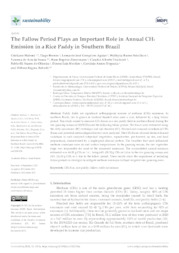The fallow period plays an important role in annual CH4 emission in a rice paddy in southern Brazil.
The fallow period plays an important role in annual CH4 emission in a rice paddy in southern Brazil.
Author(s): MABONI, C.; BREMM, T.; AGUIAR, L. J. G.; SCIVITTARO, W. B.; SOUZA, V. de A.; ZIMERMANN, H. R.; TEICHRIEB, C. A.; OLIVEIRA, P. E. S. de; HERDIES, D. L.; DEGRAZIA, G. A.; ROBERTI, D. R.
Summary: Paddy fields are significant anthropogenic sources of methane (CH4) emissions. In southern Brazil, rice is grown in lowland flooded areas once a year, followed by a long fallow period. This study aimed to measure CH4 fluxes in a rice paddy field in southern Brazil during the rice-growing season of 2015/2016 and the following fallow period. The fluxes were estimated using the eddy covariance (EC) technique and soil chamber (SC). Diurnal and seasonal variations of CH4 fluxes and potential meteorological drivers were analyzed. The CH4 fluxes showed distinct diurnal variations in each analyzed subperiod (vegetative, reproductive, pre-harvest, no rice, and land preparation), characterized by a single-peak diurnal pattern. The variables that most influenced methane emissions were air and surface temperatures. In the growing season, the rice vegetative stage was responsible for most of the measured emissions. The accumulated annual emission estimated was 44.88 g CH4 m?2 y?1, being 64% (28.50 g CH4 m?2) due to the rice-growing season and 36% (16.38 g CH4 m?2) due to the fallow period. These results show the importance of including fallow periods in strategies to mitigate methane emissions in flood irrigated rice-growing areas.
Publication year: 2021
Types of publication: Journal article
Keywords: Arroz, Fluxo de CH4, Metano, Pousio
Observation
Some of Embrapa's publications are published as ePub files. To read them, use or download one of the following free software options to your computer or mobile device. Android: Google Play Books; IOS: iBooks; Windows and Linux: Calibre.
Access other publications
Access the Agricultural Research Database (BDPA) to consult Embrapa's full library collection and records.
Visit Embrapa Bookstore to purchase books and other publications sold by Embrapa.

